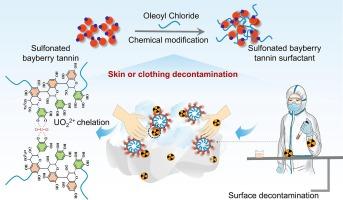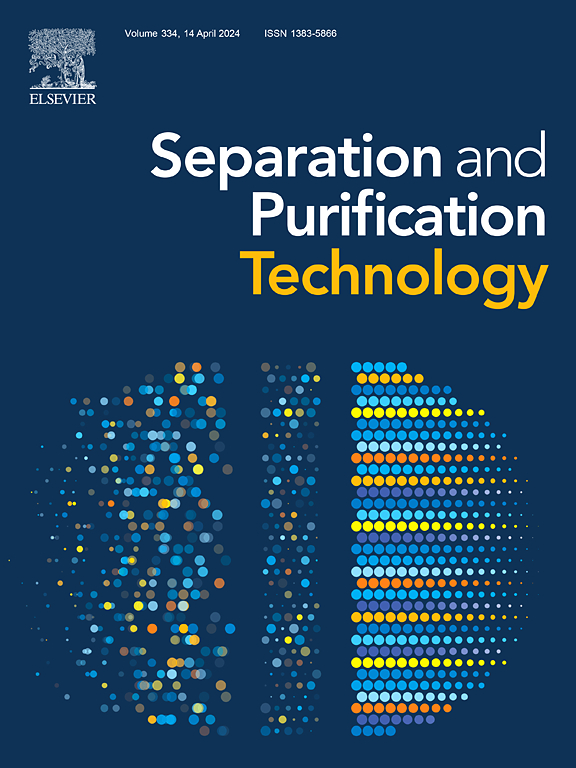制备可回收的植物多酚表面活性剂,用于高效去除皮肤和棉织物中的铀离子
IF 8.1
1区 工程技术
Q1 ENGINEERING, CHEMICAL
引用次数: 0
摘要
随着核工业对铀的需求不断增加,参与核活动的人员的皮肤或衣物受到意外铀污染的问题引起了公众的健康关注。在本文中,通过简单的弗里德尔-卡夫斯烷基化反应,对磺化月桂单宁(SBT)结构中的疏水基团进行改性,制成了一种植物多酚基表面活性剂(磺化月桂单宁表面活性剂,SBTS)。与 SBT 相比,用氯化十四烷修饰的表面活性剂具有更出色的发泡能力和乳化性能。通过傅立叶变换红外光谱对 SBTS 的表征证实,疏水链通过共价键成功接枝到 SBT 分子上。正如预期的那样,SBTS 在 pH 值接近中性的条件下可以分散在水中,并表现出良好的发泡和乳化性能。此外,该表面活性剂在广泛的应用范围内对受 UO22+ 污染的棉织物和皮肤具有有效的去除能力,对低量 UO22+ 的去除率可达 99%,对高量 UO22+ 的去除率甚至超过 55%。更重要的是,SBTS 与 UO22+ 重新接触后,在酸性和中性条件下静置 60 分钟后,很容易从水体系中分离出来,这是避免二次污染的一个有利特征。体外细胞毒性测试表明,SBTS 比常用的合成表面活性剂更安全。根据 XPS 和 FT-IR 测量结果,我们提出了一种主要源于 SBTS 的酚羟基与 UO22+ 之间螯合效应的去污机制。这项研究凸显了植物单宁表面活性剂作为有效材料去除参与各种核相关活动的人员皮肤或衣物上的 UO22+ 的潜力。本文章由计算机程序翻译,如有差异,请以英文原文为准。

Fabrication of recoverable plant polyphenol-based surfactants for efficient removal of uranyl ions from skin and cotton fabric
With the increasing demand for uranium in the nuclear industry, the unintended uranium contamination of skin or clothing for individuals involved in nuclear activities has raised public health concerns. Herein, a plant polyphenol-based surfactant (sulfonated bayberry tannin surfactant, SBTS) was fabricated by modifying the hydrophobic groups in the sulfonated bayberry tannin (SBT) structure using a simple Friedel–Crafts alkylation reaction. The surfactant modified with tetradecane chloride showed superior foaming ability and emulsifying properties compared with SBT. The characterization of SBTS by FT-IR spectroscopy confirmed that hydrophobic chains were successfully grafted on SBT molecules via covalent bonds. As expected, SBTS could disperse in water under near-neutral pH condition, and showed good foaming and emulsifying properties. Moreover, the surfactant exhibited effective removal ability for UO22+-contaminated cotton fabric and skin in a broad application range, reaching a removal rate of 99 % for low amounts of UO22+, and even above 55 % for high UO22+ amounts. More importantly, SBTS after reacing with UO22+ could be easily separated from aqueous systems after standing for 60 min in acidic and neutral conditions, which is a favorable feature to avoid secondary pollution. In vitro cytotoxicity tests suggested that SBTS was much safer than commonly used synthetic surfactants. Based on XPS and FT-IR measurements, we propose a decontamination mechanism mainly originating from the chelation effect between the phenolic hydroxyl group of SBTS and UO22+. This study highlights the potential of plant tannin surfactants as effective materials for the removal of UO22+ from skin or clothing of individuals involved in various nuclear-related activities.
求助全文
通过发布文献求助,成功后即可免费获取论文全文。
去求助
来源期刊

Separation and Purification Technology
工程技术-工程:化工
CiteScore
14.00
自引率
12.80%
发文量
2347
审稿时长
43 days
期刊介绍:
Separation and Purification Technology is a premier journal committed to sharing innovative methods for separation and purification in chemical and environmental engineering, encompassing both homogeneous solutions and heterogeneous mixtures. Our scope includes the separation and/or purification of liquids, vapors, and gases, as well as carbon capture and separation techniques. However, it's important to note that methods solely intended for analytical purposes are not within the scope of the journal. Additionally, disciplines such as soil science, polymer science, and metallurgy fall outside the purview of Separation and Purification Technology. Join us in advancing the field of separation and purification methods for sustainable solutions in chemical and environmental engineering.
 求助内容:
求助内容: 应助结果提醒方式:
应助结果提醒方式:


